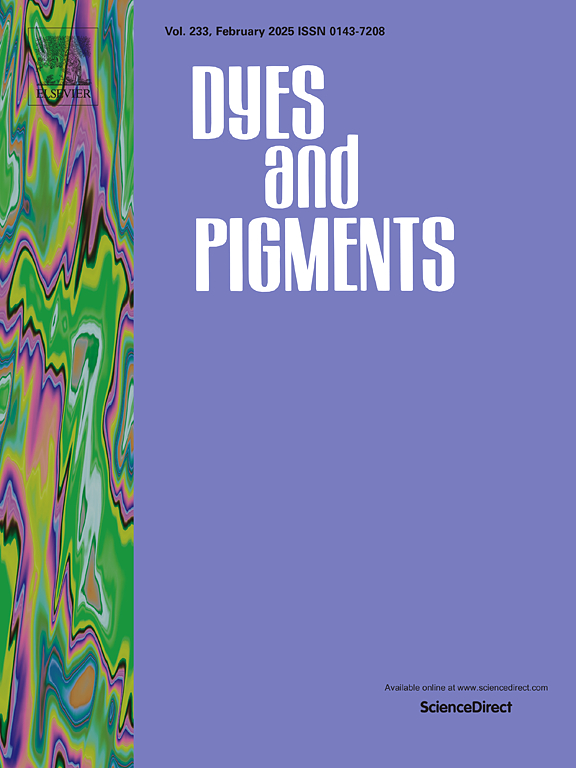Terpolymer analogous D18 enables balanced charge mobility and mitigating non-radiative energy loss of the organic solar cells
IF 4.1
3区 工程技术
Q2 CHEMISTRY, APPLIED
引用次数: 0
Abstract
Fluorine side chain engineering has been widely used to optimize the organic photovoltaic materials via the regulation of the energy levels, crystallinity, and mitigation of the non-radiative energy loss (ΔEnr) of the devices from them as well. Herein, the notable wide bandgap conjugated polymeric donor materials of D18 were optimized by the introduction of the third component of 4,8-di(3,4-difluoro-5-(2-ethylhexyl)thiophene-2-yl)benzo[1,2-b:4,5-b']dithiophene (BDT-4F) to generate the polymers with the name of D18-4F-5, D18-4F-10, D18-4F-20, D18-4F-30, and D18-4F-100 as well. As compared with the D18, the absorption spectra of analogous polymers of the D18 were almost not changed in the solid state, but the highest occupied molecular orbital (HOMO) energy levels were successively deepened, alongside the gradually increasing π-π stacking distance and decreasing the d-interlayer spacing distance in the solid state. In parallel, the open circuit voltage (VOC) of the non-fullerene-based organic solar cells (NFAs–OSCs) from the blends of the polymers paired with Y6 were increased from 0.860 V to ∼0.876 V−0.874 V, and then up to 0.892 V, alongside the decrease of the short current density (JSC) from 27.61 mA/cm2 to 20.59 mA/cm2, fill factors (FF) from 76.29 % to 53.11 %. The particular interest NFAs–OSCs with the higher power conversion efficiency (PCE) of 18.11 % relative to that of 16.89 % for the counterpart devices from the blends of D18:Y6, is achieved from the D18-4F-10:Y6 blends. Beyond that, the more balanced charge transporting, efficiently suppressed charge bimolecular recombination, and lower ΔEnr etc. of the devices of the D18-4F-10:Y6 as compared with D18:Y6, were observed and supported by a range of physical measurements.

三元共聚物类似物D18能够平衡电荷迁移率并减轻有机太阳能电池的非辐射能量损失
氟侧链工程已被广泛应用于优化有机光伏材料,通过调节能级,结晶度,以及减少器件的非辐射能量损失(ΔEnr)。本文通过引入4,8-二(3,4-二氟-5-(2-乙基己基)噻吩-2-基)苯并[1,2-b:4,5-b']二噻吩(BDT-4F)的第三个组分,对D18- 4f -5、D18- 4f -10、D18- 4f -20、D18- 4f -30和D18- 4f -100等显著的宽带隙共轭聚合物给体材料进行了优化。与D18相比,D18的类似聚合物在固态中吸收光谱几乎没有变化,但随着固态中π-π堆积距离的逐渐增大和d层间距的逐渐减小,最高已占据分子轨道(HOMO)能级依次加深。与此同时,Y6偶联的非富勒烯基有机太阳能电池的开路电压(VOC)从0.860 V增加到~ 0.876 V ~ 0.874 V,再增加到0.892 V,短电流密度(JSC)从27.61 mA/cm2降低到20.59 mA/cm2,填充系数(FF)从76.29%降低到53.11%。与D18- 4f -10:Y6共混物相比,D18- 4f -10:Y6共混物的功率转换效率(PCE)达到了18.11%,而D18:Y6共混物的功率转换效率为16.89%。此外,与D18:Y6相比,D18- 4f -10:Y6器件具有更平衡的电荷输运、有效抑制电荷双分子重组、更低的ΔEnr等特点,并得到了一系列物理测量结果的支持。
本文章由计算机程序翻译,如有差异,请以英文原文为准。
求助全文
约1分钟内获得全文
求助全文
来源期刊

Dyes and Pigments
工程技术-材料科学:纺织
CiteScore
8.20
自引率
13.30%
发文量
933
审稿时长
33 days
期刊介绍:
Dyes and Pigments covers the scientific and technical aspects of the chemistry and physics of dyes, pigments and their intermediates. Emphasis is placed on the properties of the colouring matters themselves rather than on their applications or the system in which they may be applied.
Thus the journal accepts research and review papers on the synthesis of dyes, pigments and intermediates, their physical or chemical properties, e.g. spectroscopic, surface, solution or solid state characteristics, the physical aspects of their preparation, e.g. precipitation, nucleation and growth, crystal formation, liquid crystalline characteristics, their photochemical, ecological or biological properties and the relationship between colour and chemical constitution. However, papers are considered which deal with the more fundamental aspects of colourant application and of the interactions of colourants with substrates or media.
The journal will interest a wide variety of workers in a range of disciplines whose work involves dyes, pigments and their intermediates, and provides a platform for investigators with common interests but diverse fields of activity such as cosmetics, reprographics, dye and pigment synthesis, medical research, polymers, etc.
 求助内容:
求助内容: 应助结果提醒方式:
应助结果提醒方式:


